REMEMBERING M. MANIAM
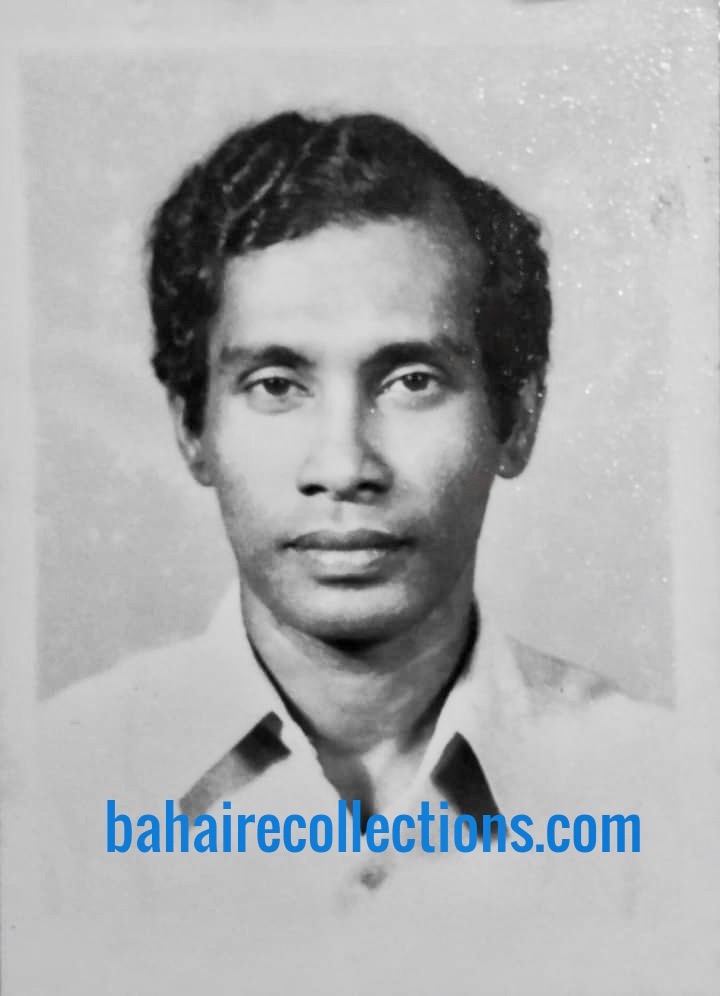
5 December 1937 to 10 July 2008
The Universal House of Justice was saddened to learn from email letter of 10 July 2008 of the passing of Maniam Muthaiah a steadfast servant of the Blessed Beauty. His devoted services as a member of the National Spiritual Assembly of Malaysia and as a pioneer to Sarawak for over four decades are remembered with loving appreciation.
With Loving Bahá’í Greetings
Department of the Secretariat
Universal House of Justice
Mr. Maniam Muthiah or affectionately called “Penghulu Maniam” was one of the great teachers of our Faith during the formative period of the Faith in Malaysia. Accepting the Faith during the Ten-Year Crusade period, he arose with such boundless enthusiasm and zeal to serve the Cause until his last days. Immediately after accepting the Faith, he became a full-time teacher and dedicated his whole life to the Cause, and happily embraced death with his boots on as a pioneer in his chosen land.
Maniam along with his classmate Jami Subramaniam, associated with the believers of Malacca town since early 1957 while still church-going students when studying at the Methodist English School. These two were about to be baptized after being exposed to Christianity. But it was just then that the Healing Message of Bahá’u’lláh wafted over them. Both started to investigate the Faith and soon accepted the Faith in 1957. They were deepened by Mr. Leong Tat Chee and Mr. Saurajen, the two early believers of the Malacca town community. Upon accepting the Faith, Maniam was actively involved in the local Bahá’í activities.
After his studies, Maniam was looking after his family business in managing a sundry shop and involved in part-time gardening work. Keenly involved in the activities in Malacca, Maniam rose as one of the strongest pillars of the Faith. Maniam had a very good understanding of the Cause of Bahá’u’lláh, in the early days of his acceptance of the Faith through some rare experiences and exposures that were well enjoyed only by the first batch of believers in the country. One was attaining the presence of the Hands of the Cause of God and basking under their talks that moved the hearts.
It was at the first summer school held in December 1957 in Malacca that Maniam attained the presence of the Hand of the Cause of God Dr. Rahmatu’lláh Muhájir, and he continued to enjoy the bounty of attaining his presence in many of Dr. Muhájir’s return visits to Malaya. And at the Third Pan-Malayan Teaching Conference held in February 1961 in Malacca, Maniam attained the presence of Hand of the Cause of God Ṭaráẓu’lláh Samandarí. He attained the presence of Hands of the Cause of God Mr. Abu’l-Qásim Faizi and Miss Agnes Alexander in early October 1958 when they came together to grace the wedding of Tony Fernandez and Betty. Maniam also attained the presence of Amatu’l-Bahá Rúhíyyih Khánum when she first visited Malaya in 1961 and later in 1964 when she came for the first national Bahá’í convention in Kuala Lumpur. At the election of the first National Spiritual Assembly of East Malaysia in 1972, he attained the presence of the Hand of the Cause Mr. Jalal Khazeh which happened to be his only visit to this country. In his talks, Maniam used to quote the advice and words of guidance uttered by these highly distinguished Hands.
Yet another event that enabled Maniam to gain a deep understanding of the Cause was the impactful Sunday Classes that Mr. Kumara Das, Mr. Anthony Louis, and Mr. Saurajen conducted in 1958 for the Bahá’í youths in the Malacca High School. Those classes were held to activate the first batch of youth that had accepted the Faith. The Sunday Classes deepened some of the best known and most abled believers such as Jami Subramaniam, Leong Ho San, Errol Seow Hoon Hin, Purushothman Nair, and Maniam who would in the years ahead go on to serve the Cause most devotedly, after being well-grounded in the basics of the Faith.

A gathering of adults and youth at the Boy Scout Headquarters, circa 1958. Kumara Das is in the middle with a black necktie. Anthony Louis is squatting at the extreme right. Koh Ai Leen is standing at the extreme right. Lily is standing third from right, Raymond Peter stands eighth from the right with sunglasses. Leong Ho San is standing fifth from left, with M. Maniam standing in front of him. The three squatting from left are Pijush Kanti Paul, Tushar Kanti-Paul, and Jami Subramaniam
In 1961, Maniam was appointed on the “Watch Committee” under the Local Spiritual Assembly of Malacca town. The function of this Watch Committee was to assist in the consolidation of the community, especially in bringing back to the fold those dormant Bahá’ís who had not been attending Nineteen Day Feasts and fireside meetings for a long time. The Local Spiritual Assembly had prepared a list of such dormant believers and Maniam and a few others visited them and did succeed in winning them over.
In 1962, Maniam was tasked with undertaking single-handed trips to the rubber plantation settlements in the state of Malacca. The Local Spiritual Assembly of Malacca town sent Maniam to these rural areas to consolidate the many people who had come into the Faith in large numbers. In one of those trips, Maniam was caught in a very tricky and uncomfortable situation. In one rubber plantation settlement, the labourers were going to strike for not being paid enough wages. This posed the Local Spiritual Assembly a delicate dilemma as some labourers were followers of the Bahá’í Faith as well. The Assembly conveyed to Maniam to get the believers out of these strikes. Maniam traded only too well in the deep waters and came out triumphant in dissuading the believers from going on strike. When the strikes were called off, the estate management observed that the followers of the Bahá’í Faith among the labourers had kept away from the strikes, and the estate management rewarded the Bahá’í workers who kept away from the strike. When the Local Spiritual Assembly came to know of this, the institution appreciated Maniam for carrying out the delicate task with success.
Throughout 1962, Maniam was somewhat a full-time teacher of the Faith and involved in teaching activities in the rural areas. At one particular moment, Maniam ran short of money and was subsisting by visiting the coffee shops in that area and surviving by eating bread crusts alone. Maniam did not inform the Local Spiritual Assembly. Yet this poignant news reached the Local Spiritual Assembly which found it was not possible to get the necessary funds to be sent in time to Maniam immediately. The always generous-hearted Raymond Peter rushed to his grocery shop in Jasin town and bought some provisions on credit. Next, Peter took his radio to another shop and sold it at less than half the price and with the money bought more provisions and sent them over to Maniam. Maniam related this incident to many friends and to his family till his last days. Peter was always fond of Maniam for being a good fieldworker and a committed servant of Bahá’u’lláh and kept in touch with him all his life.
The year 1963 became a turning point for Maniam. While the Cause was progressing reasonably well in Peninsula Malaya, there was a need for abundant manpower to toil for the Cause in the Borneo territories. The Regional Spiritual Assembly of Southeast Asia decided to send three believers to the Borneo territories – Yankee Leong and Maniam from Malaya and Abolfazl Bijan Bayzaee, a travel teacher from Iran.
Bayzaee arrived in December 1962 in Bangkok and came over to Singapore, waiting for instructions from the Regional Spiritual Assembly on his posting. Mrs. Shirin Fozdar was on her way to Jakarta for the meeting of the Regional Spiritual Assembly where Hand of the Cause of God Dr. Muhájir was to be present. Bayzaee wrote a letter to him through Mrs. Shirin Fozdar, and in the letter, he had indicated his willingness to serve in any part of the region. Meanwhile, Bayzaee travelled around Port Dickson, Seremban, Kuala Lumpur, and Alor Star. It was while he was in Seremban that news came that the Regional Spiritual Assembly had decided to send him, Yankee Leong, and Maniam to the Borneo state of Sarawak. Yankee Leong had already been to Sarawak in 1960 and was quite familiar with the conditions there. Raymond Peter, the big-hearted believer from Malacca always had a great liking for Maniam, and the moment he heard that Maniam was going to Borneo Islands, Peter being a Health Inspector knew of the prevalent malarial disease in the interiors, spread by mosquitoes, and so he gave Maniam a blanket and a mosquito net that is still kept by the family to this day.
From Malaya, the three arrived in the house of Mrs. George Lee in Singapore and bought some important needs to be taken with them. From there they took a cargo boat and arrived in Kuching after three days of sea journey and stayed in a modest hotel. In Kuching, Yankee Leong met a Chinese friend who arranged dinner and fireside where the former spoke on the Faith. Their next stop was Sibu where they attempted to teach the Chinese people there. There they met Mr. Chi Chia Qui and his wife Mei Si Chi who were among the first batch of believers in Kuching. Mr. Chi Chia Qui served as the Vice Chairman of the first Local Spiritual Assembly of Kuching in 1953 during Jamshed Fozdar’s time.
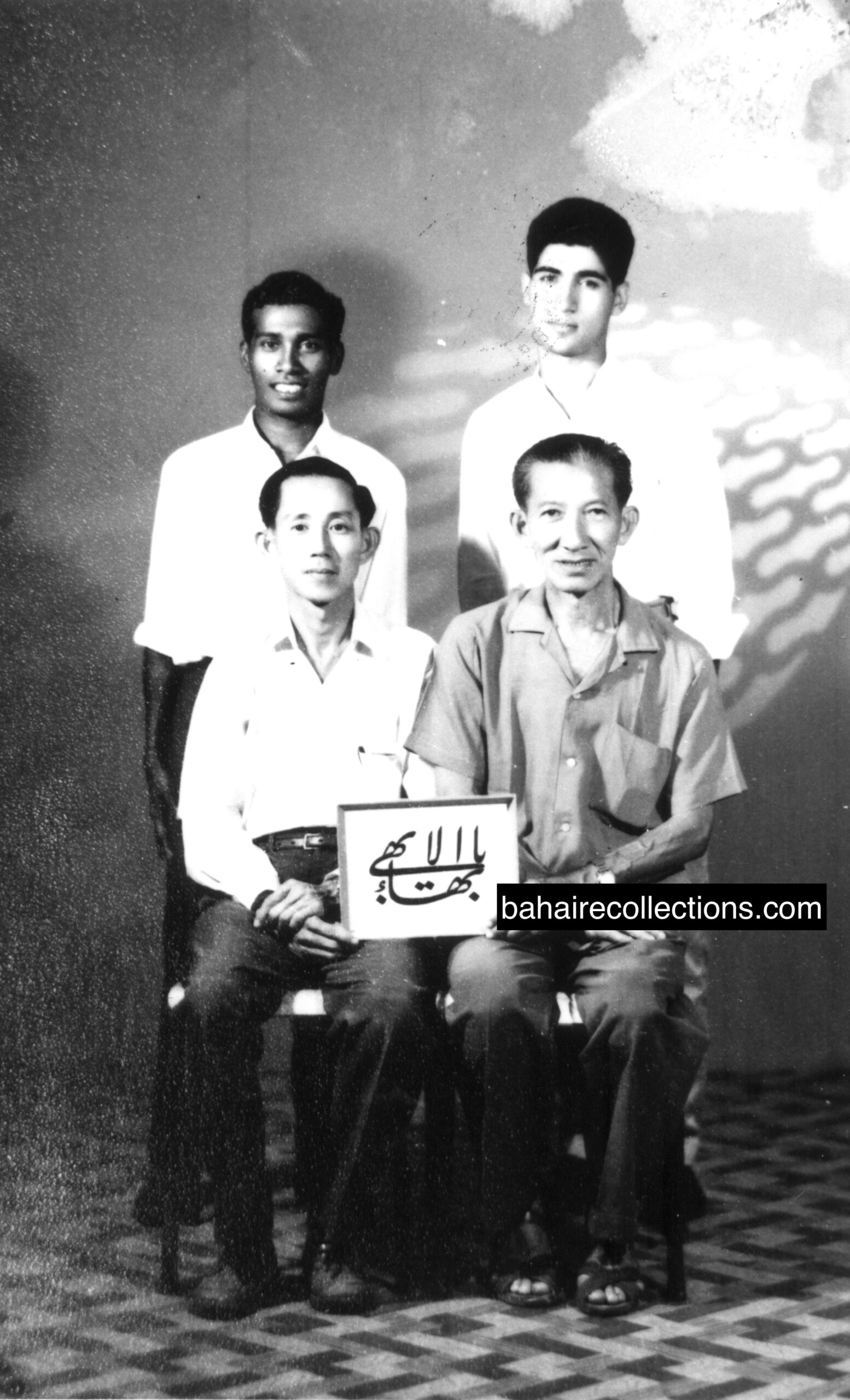
March 1963. Standing Maniam at left and Bayzaee at right. Sitting L-R: Mr. Mr Ong Chuan Choon and Yankee Leong. Mr Ong Chuan Choon was the first Bahá’í of Kanowit and a headmaster there. He was originally from Sibu.
Their next stop was Kapit town where the three established their base. They first stayed on the first floor of a shophouse belonging to a Chinese man, who sold jewelry and rubber sheets on the ground floor. Yankee Leong was their guide and mentor on how to present the Faith to the Iban people (native people of Sarawak) in the longhouses and gave them all the words of encouragement for the wonderful services they were rendering the Cause. He would on occasions have told Maniam and Bayzaee what instructions he had received from Dr. Muhájir.
Bayzaee recalls what he witnessed as he and Maniam arrived in Kapit. The infrastructure was still at an infant stage, with only the Government Rest House as the only visible building. Public transport was unheard of or very rare. Roads in the town were almost empty. Rivers had to be crossed by boats and ferries. Life was difficult, but the love for the Cause and the trust the Regional Spiritual Assembly of South East Asia had in them were the propelling forces for them to soldier on.
The three were very successful in their very first visit to the longhouse in the most remote locality of Sepulau along Sungai Gaat in Kapit district. lt would take about a full day journey by longboat from Kapit to reach that remote area where he was able to establish the Faith. Yankee Leong would make the presentation of the Faith in the evenings when all the families in the longhouses had returned from farming and hunting. After dinner, they all gathered at the common meeting ground and Yankee Leong would introduce Maniam and Bayzaee, saying that they were from Indian, Persian, and Chinese backgrounds but united in one common Faith whose membership comprises a microcosm of the entire race throughout the world and that they were inviting the Ibans to join in this world fellowship of unity in diversity. As Yankee Leong would continue his presentation, Maniam and Bayzaee would distribute brochures and photos of the Bahá’í gatherings throughout the world published in the Bahá’í News magazine published by the National Spiritual Assembly of the Bahá’ís of United States. They succeeded in enrolling no less than a thousand new believers. After mid-1963 Maniam and Bayzaee established cordial relationships with one Penghulu Kumbong who was the powerhouse of Bahá’í activities in Kapit. Association with Penghulu Kumbong further enhanced the activities in the area.
In Kapit town too they were involved in robust teaching activities and opened new areas for the Faith. Three foreigners serving in the Kapit Electric Company came into the Faith- Mr. George Walter, Mr. Edward Bahoe, and Mr. Asong. They could speak some Iban language and helped the three to purchase a boat and an engine for travelling and visiting the Bahá’í longhouses for the consolidation works. They named the boat “The Dawn-Breakers”. They also were recipients of two American travelling teachers who accompanied them during their consolidation visits in the longhouses – Ms. Delores Margaret Thomas and Mr. Earl Mock.
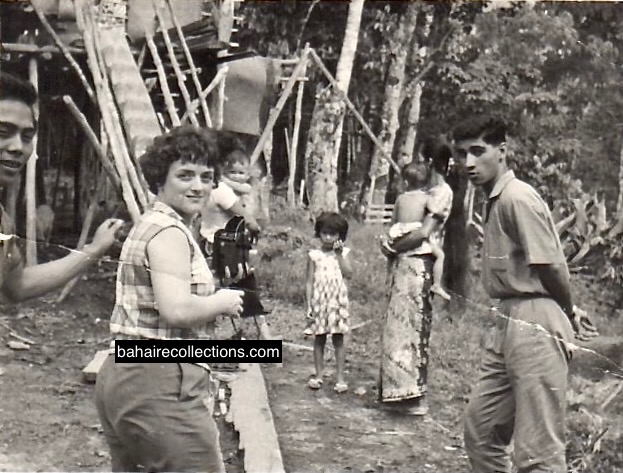
Ms. Delores Margaret Thomas and Bayzaee
While in Kapit, Bayzaee produced the Arabic version of the Greatest Name in the fashion standardized by the famous calligrapher Jináb-i-Mishkin Qalam on a 3×5 feet board. Both Maniam and Bayzaee never missed out on any opportunity to teach the Cause. There was a time when Bayzaee was admitted into the Christian Missionary Hospital that was run by the Seventh Day Adventist denomination. Bayzaee presented his doctor with the book “Christ and Bahá’u’lláh”.
Maniam wrote a report to the Regional Spiritual Assembly of South East Asia, which was published in its newsletter Bahá’í News for April 1963. Maniam wrote, “On 28 March, we crossed the river opposite Kapit and walked about six miles before reaching the houses where we found a few people. The rest of them were in the fields. We planted the seed of Bahá’u’lláh in their hearts and they have invited us again. Throughout the journey to this home, we walked in mud, bushes, over hills, and in the river. We fell, hurt, and bled before reaching the house. On 29 March we sailed with Mr. Walter to a different area and reached a longhouse. Here we found only one soul as the rest were in the fields.”
The Bahá’í News for April 1963, also proudly reported the great services of Yankee Leong, Maniam, and Bayzaee in Borneo. Part of the report read, “Mr. Yankee Leong and Mr. Maniam from Malaya and Mr. Bayzaee of Iran spent more than one month in propagating the Faith in Sarawak. They taught in the Third Division of Sarawak and were instrumental in attracting more than 1,000 people to the Faith. The success they encountered has far exceeded their hopes. Heartened, they hope now for an even greater outpouring of Divine Grace to guide many more to the Cause of God.” The same newsletter for April 1963 published that the three were recipients of a most joyful congratulatory message from the Hands of the Cause of God in Haifa.
Yankee Leong returned to Singapore to prepare to attend the First Bahá’í World Congress in London. Maniam and Bayzaee remained in the Kapit district as pioneers to consolidate the teaching work already done. After Yankee Leong had left, Maniam and Bayzaee rented a room in the town.
MANIAM BECOMES “PENGHULU”
Maniam and Bayzaee made frequent visits to the Sungei Gaat area. Here they faced many difficulties in an unknown land, and with people of unknown culture and language. They often slept on the boats, and it did not take long before they started to win over the hearts of the Iban people, who lived in the longhouses. They started to live as one among the Iban people in the longhouses. They even started to partake of their food, especially “kasam” a traditional favorite cuisine of the Iban people, made by fermenting meats, predominantly pork. Maniam especially also dressed in the local costume and danced with them during local festivals. Maniam on his part sang popular songs from the Tamil movies to entertain the Iban people. Once Maniam was able to converse well in the Iban language, he started to teach them the Faith giving all the counsels that Bahá’u’lláh had taught. “Penghulu” is the title given to a community leader in a particular area. It was always customary for the Penghulu to give counsel, guidance, and advice. And it was while serving in Sungai Gaat, that the local Bahá’ís affectionately started to call Maniam “Penghulu” on account of the strong words of guidance and wisdom that Maniam gave from the Writings.
Maniam’s services in Sarawak were truly excellent and came to be recognized even in the international arena. Dr. John Fozdar who became a Knight of Bahá’u’lláh for settling in Brunei attended the first International Convention to elect the Universal House of Justice in 1963. When Dr. John Fozdar went to see Maniam in Sibu where Maniam was staying at the time of that visit, he conveyed to Maniam a firsthand account of the proceedings of that international event. Further, Maniam was very much inspired when Dr. John informed him that the Bahá’ís who had gathered at the Convention had prayed for all the pioneers around the world. That inspired Maniam and served as a catalyst for him to rise to a higher level in the field.
RETURNS TO WEST MALAYSIA
Maniam was in Sarawak for nine months during which time he underwent many hardships. On 16 September 1963 was the formation of Malaysia with the states of Sabah, Sarawak, and Singapore joining Peninsula Malaya as one political entity. There was a big celebration in Kapit, which Maniam and Bayzaee witnessed. The formation of Malaysia sparked off a confrontation between Malaysia and Indonesia. Maniam found that he could not get his visa extended, and the interiors of Sarawak were not safe owing to the confrontation. Therefore, he was forced to return to West Malaysia on 24 October 1963.
As for Bayzaee, his visa for Sarawak was extended twice, but the authorities refused to extend any further. And so Bayzaee traveled to Brunei and stayed with the family of Mr. Minoo Fozdar. For the last three weeks of 1963, Bayzaee stayed with Dr. John Fozdar, a Knight of Bahá’u’lláh, and his family in Sandakan before returning to Laos through Singapore in February 1964.
While Maniam and Bayzaee were in Sarawak they were successful in establishing more than one hundred Local Spiritual Assemblies in Sarawak through their vigorous teaching activities. They had their own challenges and struggles in the field. While Yankee Leong was with them in the early part of 1963, it was Yankee Leong who gave them all the words of encouragement to soldier on. After he had left, the constant string of letters of encouragement from Jamshed Fozdar, Chairman of the Regional Spiritual Assembly of South East Asia and based in Saigon gave them all the needed strength. Jamshed Fozdar was the first to have taught the Faith in Sarawak when he went there in 1951 and the beloved Guardian referred to him as the Spiritual Conqueror of Sarawak. Occasionally, Mr. Kamran Samimi, another member of the Regional Spiritual Assembly of South East Asia too sent them letters of encouragement.
However, his invaluable services in Sarawak were very greatly needed as the vacuum created by his return from Sarawak could not be adequately and immediately filled. Therefore, on behalf of the National Teaching Committee, its members Mr. Inparaju Chinniah or Inbum Chinniah as he was fondly called and Mr. Raymond Peter urged Maniam to return to Sarawak, with the confrontation situation between Indonesia and Sarawak toning down. But for the first time, Maniam spoke his mind and opened the eyes of Peter and Inbum. And that conversation was a turning point for Inbum and Peter. When Peter and Inbum gave all the words of encouragement to Maniam to return to Sarawak, Maniam retorted saying he was not interested in pep talks. Maniam said giving words of encouragement and giving a grand sendoff was the easiest, but what was more important was to monitor and care for the travel teachers and pioneers who were in the interiors. Maniam mentioned for the first time some of the untold sufferings he had undergone in Sarawak. Apparently, on several occasions, he almost drowned in the rivers, and on several other occasions, he either fell seriously sick or ran out of food. Suffering in silence, he never complained to anyone at that time, and his only trust was the helping hand of Bahá’u’lláh. For the first time, he reported this to Peter and Inbum. Having spoken his sufferings, he broke down. Inbum was almost in tears while Peter was very disturbed. It was partly this heated conversation that planted the seeds for Inbum and Peter to serve the Cause abroad. History has it that with the constant encouragement by Hand of the Cause of God Dr. Rahmatu’lláh Muhájir, Peter pioneered to Ceylon from the end of 1969 to mid-1973, while Inbum went to Tanzania for six months at the end of 1972. But the shot was given first by Maniam in that heated conversation between the three in 1963.
But his extensive and rich experiences in Sarawak could not be erased from his soul. Maniam was already a well-grounded field worker in the jungles of Sarawak. When the first national convention for the election of the National Spiritual Assembly of Malaysia was held in Kuala Lumpur in April 1964, Maniam was invited to give a talk on the topic of “Taking the Faith to the minority groups in the Borneo territories”. Hand of the Cause of God Amatu’l-Bahá Rúhíyyih Khánum who was the official representative of the Universal House of Justice at the convention was so impressed with his services in Sarawak that she requested him to excel in that area of service for the Cause.
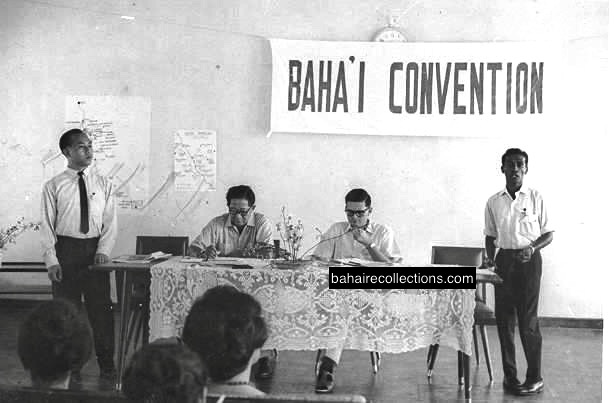
National Bahá’í Convention in Kuala Lumpur, 1964. Maniam, at right, speaks while Phung Woon Khing on left translates. Seated are Leong Tat Chee left and Harlan Lang at right
Meanwhile, Maniam was fully involved in full-time travel teaching in West Malaysia from the time he returned from Sarawak. While Maniam was trying to settle for some path of service in West Malaysia, Dr. R. J. Wolff, a Bahá’í from Hawaii, who had come to study the dietary habits of the aborigine people in Malaysia offered Maniam accommodation at his home in Petaling Jaya. Maniam thus had undertaken visits to the aboriginal villages in the jungles of West Malaysia. To this day he is still remembered by the early Asli believers, especially around Sungkai in Perak state.
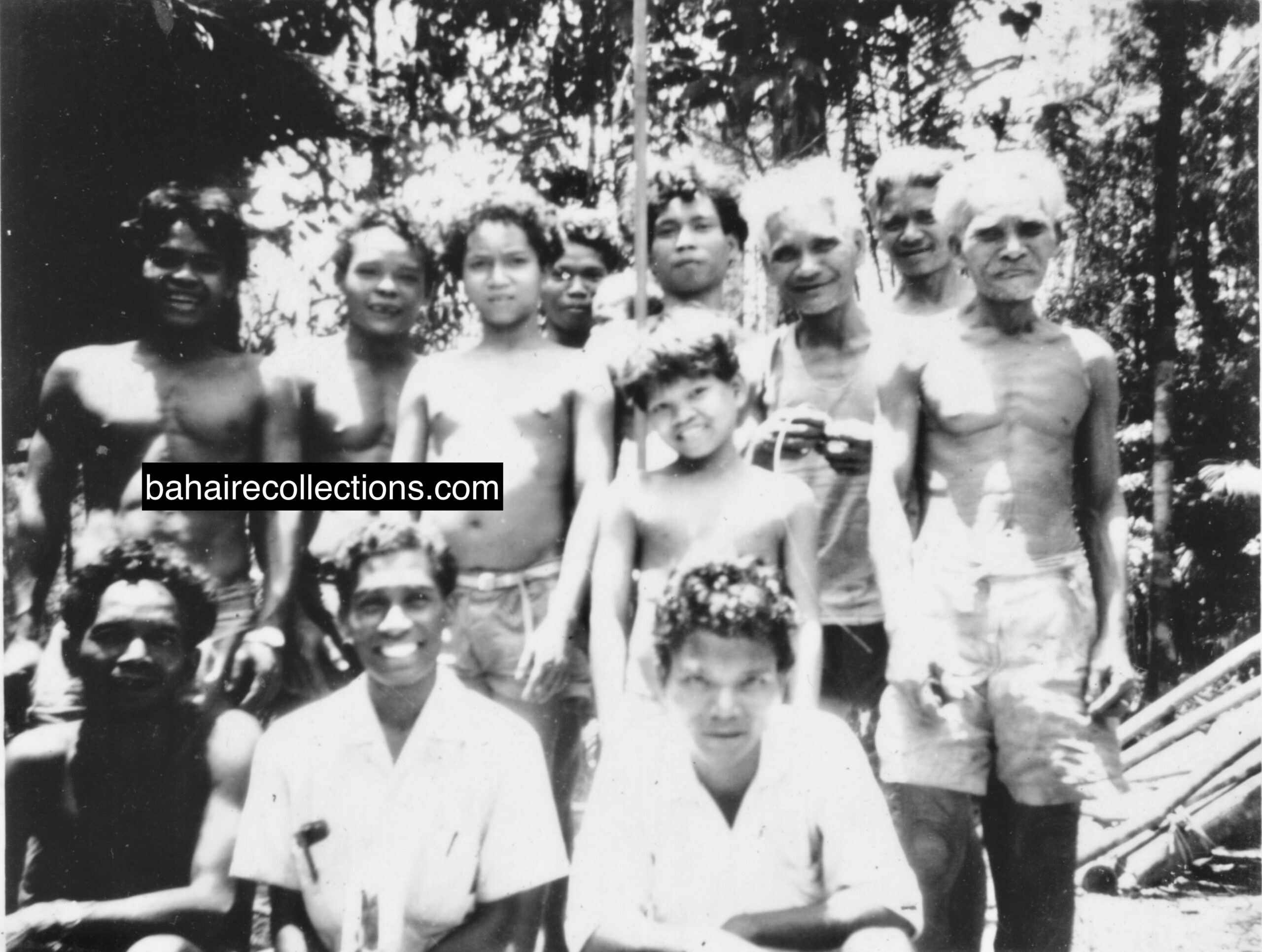 Maniam with the aboriginal friends
Maniam with the aboriginal friends
Maniam then wrote a very moving letter to the National Teaching Committee: “…I am offering myself to the National Teaching Committee and am prepared to accept whatever decisions they may have for me.” The National Teaching Committee was very moved by the sincere tone of that letter. Seeing that Maniam had submitted himself to any path of service, the National Teaching Committee conveyed its loving appreciation for his efforts and sacrifices for the Cause of Bahá’u’lláh and offered him all the assistance in making him a full-time teacher for the Cause in West Malaysia.
For three years he was involved in full-time travel teaching in West Malaysia and attended many Bahá’í gatherings. In 1964, he went to assist in developing the Faith in Kuantan town in the state of Pahang till 1965. The outbreak of cholera in the east coast states of Kelantan, Terengganu, and Pahang in the mid-1960s took Raymond Peter of Malacca to these places where he was successful in eradicating cholera and serving the Cause effectively. When Peter was in Terengganu in 1964, he invited Maniam to stay with him to teach the Faith. It was in June 1965 that the National Spiritual Assembly of Malaysia released the first issue of the Malaysian Bahá’í Magazine. Several regional correspondents were appointed for various parts of Malaysia to send reports. Maniam was one of the regional correspondents for this magazine for the East Coast and wrote comprehensive and moving reports to this magazine which were published in the very first maiden issue.
After serving in Kuantan, Maniam came to serve in the Bagan Serai community in the state of Perak in 1965. Mr. Tony Fernandez and his wife Betty had moved from Malacca to this community in late 1963. While Tony moved in the higher echelon as Assistant Superintendent of Police in the Krian District, and Betty as a teacher moved in the middle-income society, they still needed some field worker to take the Cause to the grassroots. Maniam fitted that role very well and at the same time teamed up very well with them. It was while here that Maniam brought several people into the Faith. Two of the gems were Mr. Thinathayallam Ponnusamy and Mr. Munusamy Nathamuni. These two were studying in the school where Betty taught. Thinathayallam had accepted the Faith through Maniam in the home of Tony Fernandez on 25 December 1965. Munusamy had heard of the Faith through Betty in 1963, but it was Thinathayallam who took Munusamy to the same house where he signed up in the dining hall in 1966. Betty gave Munusamy a prayer book and a copy of the famous Bahá’u’lláh and the New Era book by John Esslemont. Thinathayallam and Munusamy later rose to serve the Cause with distinction.
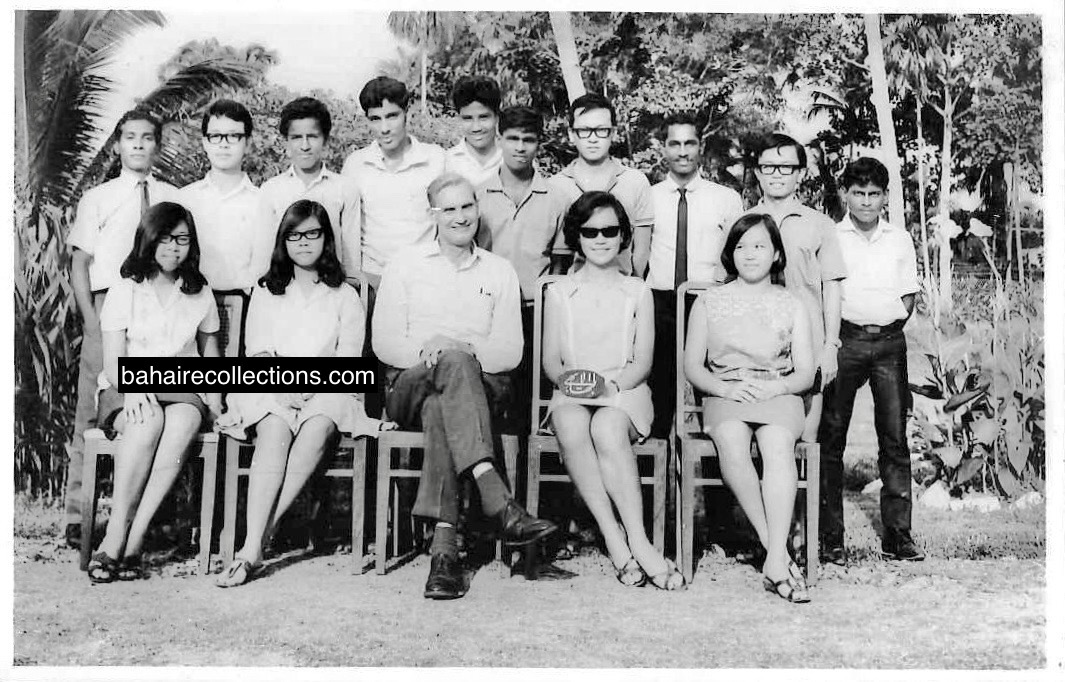
Some believers in the Bagan Serai community with a visiting American believer seated in the center, 1966. Standing at extreme left is Maniam, and N. Munusamy stands fourth from left
When the National Spiritual Assembly of Malaysia appointed the first Asli Teaching Committee in 1967, called the Aborigine Committee then, Maniam was a natural choice to be included in this committee.
TO SARAWAK FOR GOOD
Maniam attended the Intercontinental Conference held in New Delhi, India in October 1967, and was very moved by the talks by the three Hands of the Cause who were present- Dr. Muhájir, Mr. Abu’l-Qásim Faizi, Dr. ‘Alí-Muḥammad Varqá, and General Shu’á’u’lláh ‘Alá’í. This conference strengthened his resolve to rise to a higher level of service in the Cause. By this time Maniam’s unique services and commitment to teaching the natives of the interior of Sarawak were already well known to even international institutions. In 1967, three parties- the Universal House of Justice, Hand of the Cause of God Dr. Rahmatu’lláh Muhájir, and the National Teaching Committee of Malaysia urged Maniam to return to Sarawak as the vacuum created by him was yet to be adequately filled. Therefore in 1967 Maniam returned to Sarawak, and once again traveled into the interiors and became an undisputed worker for the Cause. When Maniam returned to Sarawak the domestic situation was more settled. Sarawak which fell under the National Spiritual Assembly of Malaysia was well guided in every way by the national institution. Dr. John Fozdar who had already moved from Sandakan into Sarawak was a beacon of guidance for the nascent community in Sarawak. Maniam had a wonderful working relationship with Dr. Fozdar and his wife Mrs. Grete Fozdar throughout his life. Their presence itself was a big strength for Maniam.
From the moment Maniam returned to Sarawak, he was clear in his mind never that he would never return to West Malaysia. He wanted his bones to be buried in the land where he had decided to pioneer. Maniam had grown under the loving shadow of saintly figures like Yankee Leong and Leong Tat Chee, and their guidance had been a great motivating force in his life, not to forget his meeting with Hands of the Cause of God. Maniam often quoted what Leong Tat Chee used to say, “A pioneer is one who buries his bones in the country where he pioneers.” Maniam was always on the move into the interiors of the state and when was back to Kuching he used to stay in the rented Bahá’í Centre.
Maniam once again proved to be a great asset in the field of teaching in Sarawak. The National Spiritual Assembly of Malaysia in its Feast Newsletter dated 21 March 1968 for the month of Bahá reported that Maniam had visited 15 villages and 5 were opened to the Faith with many declarations.
When a Bahá’í Teachers Training Course was conducted at the National Bahá’í institute in Malacca in September 1969, Maniam spoke on the topic of “My Experiences in Teaching the Faith in Sarawak.” His talk was well-received, with appreciation. Among the hundreds of people to whom Maniam gave the Faith was Ragai Lang. Ragai Lang went to visit his uncle who was a Bahá’í in Sungei Turong in the Samarahan District in 1970. That was the occasion where Grete Fozdar officially opened the Bahá’í Centre in Sungei Turong. As no translator was available Ragai Lang was called upon to translate for Grete Fozdar, after which she discussed the Faith with him. Maniam who was also at that event came visiting Ragai Lang on two occasions later and on his second visit presented Ragai Lang with the book Bahá’u’lláh and the New Era on behalf of the Bahá’í Teaching and Administrative Committee of Sarawak. Ragai then accepted the Faith.
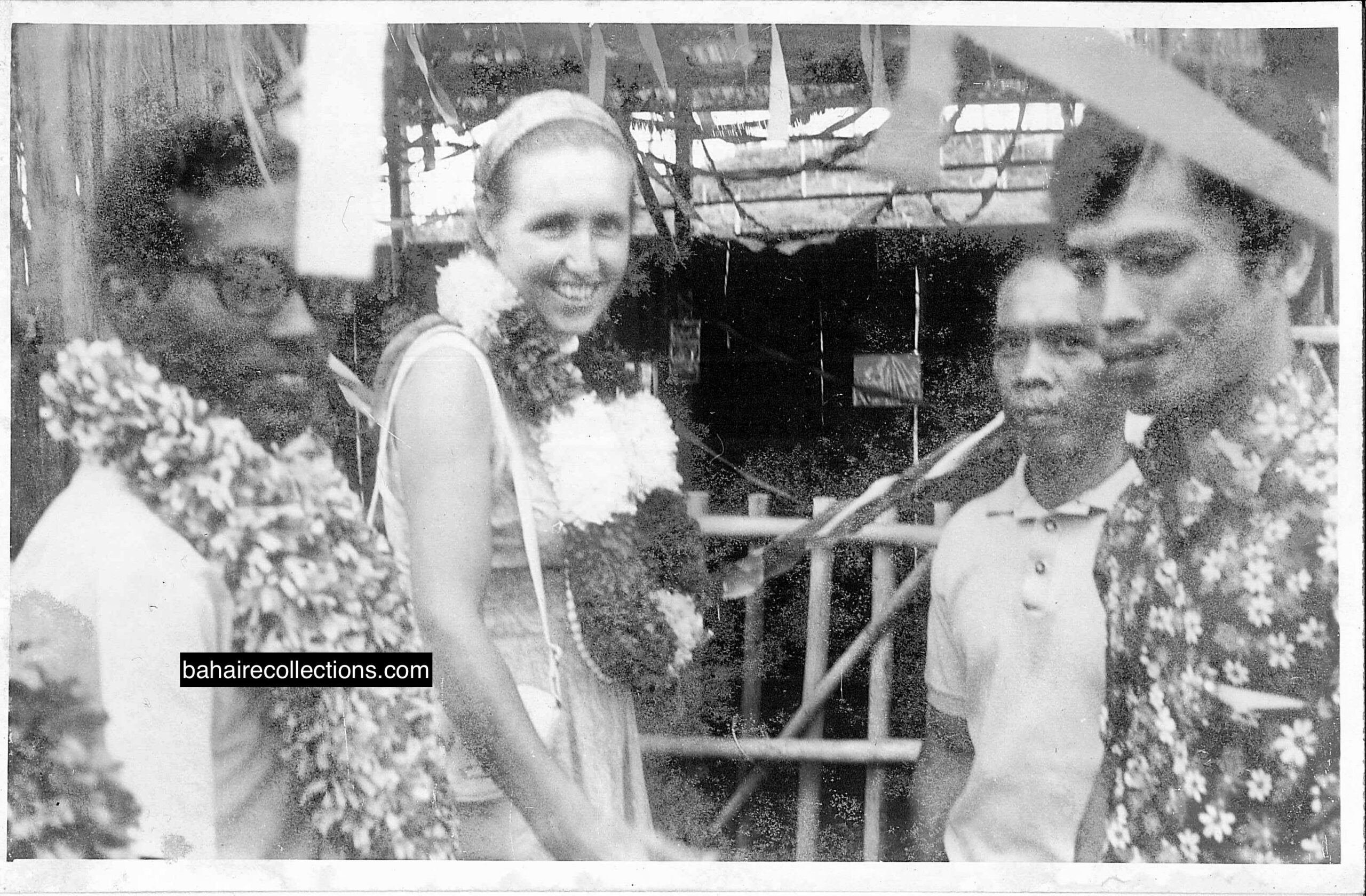
Maniam and Auxiliary Board member Mrs. Grete Fozdar at the official opening of a Bahá’í Centre at Sabal Aping, Second Division on 27 June 1972. The Bahá’í Centre was built by the people of Sabal Aping. More than 60 friends, including three members of the National Spiritual Assembly, participated in a day-long teaching conference

Maniam manning Bahá’í exhibition at the Annual Trade Fair in Kuching, circa 1972

Bahá’í Teachers Conference held at the Bahá’í Centre of Kuching in October 1973. Standing at the extreme right, from R-L Maniam, Ragai Lang, and G. Kuppusamy
Among the many well-remembered activities that Maniam initiated was one Inter-Youth Conference that Maniam organized in Kampong Triboh, Serian in the First Division of Sarawak on 24 and 25 December 1972, with the aim of promoting interaction and fellowship among the youths in Sarawak. A bus was chartered to gather friends from several spots and transport them to the conference venue.

Inter-Youth Conference in Kampong Triboh, Serian. L-R: Frankie Ang, Raymond Song, Peter Wang, Maniam, Upendra Ravi, Ragai Lang, Christine Chan, (Air Force man) Cecelia, (unknown) Judy Wee, Sapong Andar, Desmand Choo, Appalasamy, Howard Tsai, Wong Fook Yee, Elam ak Kanang
Having decided to root himself permanently in Sarawak, he started to look for a livelihood to be more independent. He had pioneered at a time when the situation was very difficult. Maniam started repairing radios, typewriters, and cars and then moved on to sell furniture. However, he still went through untold sufferings which he did not share widely with others. He was also an active insurance agent and ran an air ticketing agency as well. Later he had a gift shop in the army camp near the Kuching Airport.
Having decided to bury his bones, in Sarawak, he next decided to get married to a native of Sarawak. On 17 June 1975, Maniam married a local Iban believer Miss Nyamut Gelai, thus becoming the first believer of the Indian race of Tamil extraction from Malaysia to have married a native believer of Sarawak. This marriage further cemented his love and ties with the Iban race.
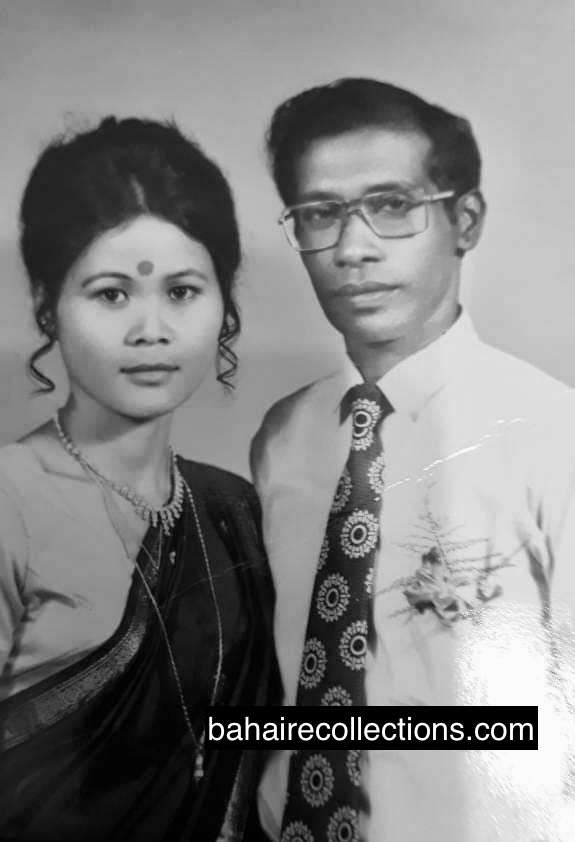
Nyamut and Maniam
The National Spiritual Assembly of Malaysia, comprising Peninsula Malaysia, Singapore, and the Borneo states of Sabah and Sarawak, with its seat in Kuala Lumpur was elected in 1964. In 1972 when a separate National Spiritual Assembly was elected for East Malaysia and Brunei, Maniam was elected to this national body and was reelected onto this body in the following year of 1973. Again in 1974 when the National Spiritual Assembly of East Malaysia and Brunei and the National Spiritual Assembly of West Malaysia were merged into the National Spiritual Assembly of Malaysia, Maniam was elected on this body and served for many years.

National Spiritual Assembly of East Malaysia and Brunei, 1972. Seated L-R: Choo Yeok Boon, Dr. John Fozdar, Rusi Irani and Maniam. Standing L-R: Ragai anak Lang, Thinathayallam, Lim Boon Huat, G. Kuppusamy and Sapong Andar

Winter School in Johor Baru, December 1974. Standing are members of the National Spiritual Assembly L-R: Maniam, Ganasa Murthy, Yin Hong Shuen, Isaac D’Cruz, S. Nagaratnam, Captain Choo Yeok Boon, Dr. Singaraveloo, Dr. John Fozdar, and Ragai Lang. Seated L-R: Auxiliary Board member Shantha Sundram, Counselor Dr. Chellie John Sundram, Counselor Yankee Leong, and Auxiliary Board member Inbum Chinniah
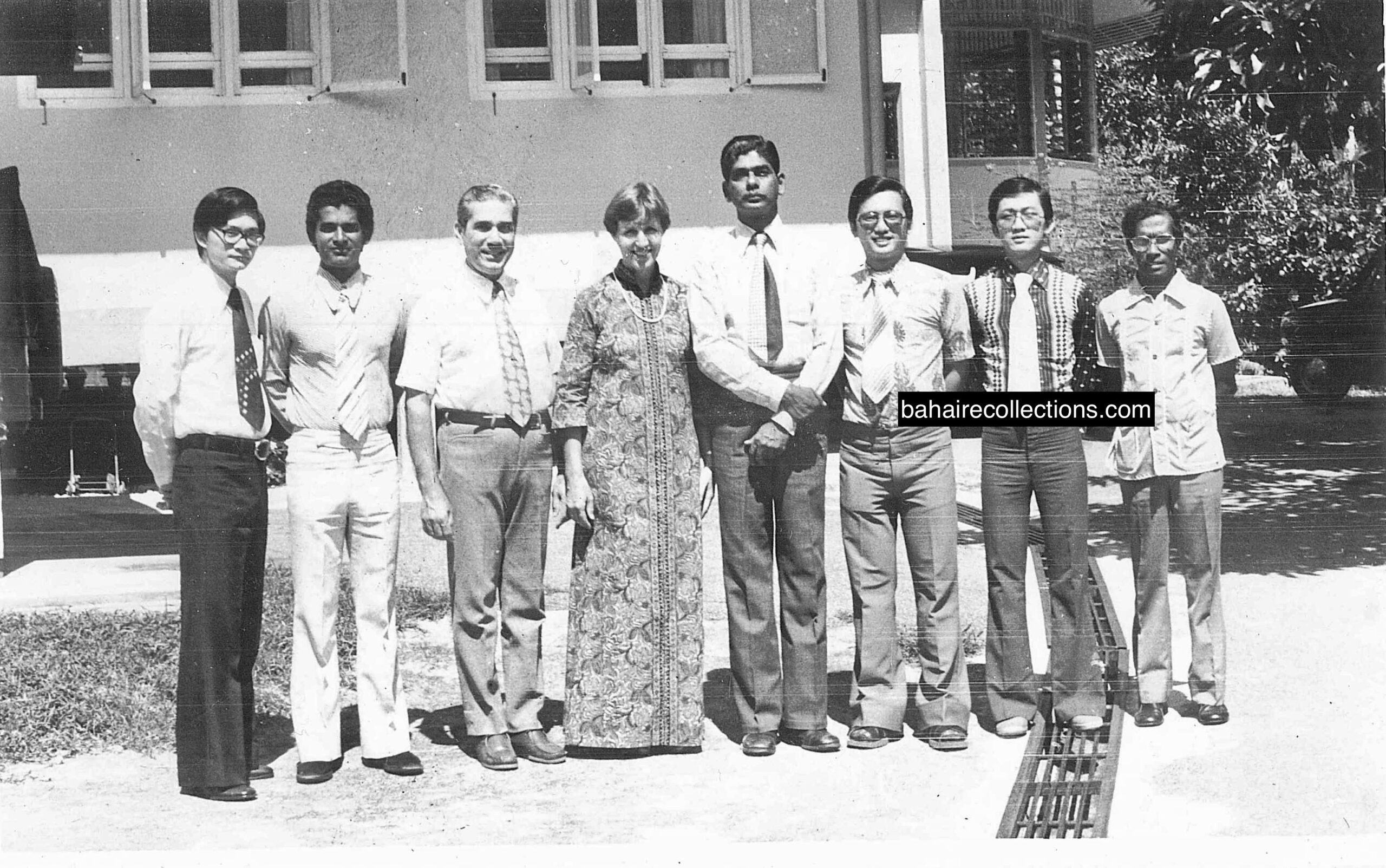
Meeting of the National Spiritual Assembly of Malaysia at the residence of the Fozdars in Kuching, 1979. L-R: Yin Hong Shuen, Isaac D’Cruz, Dr. John Fozdar, Mrs. Grete Fozdar, S. Nagaratnam, Lum Weng Chew, Lim Pun Huat, M. Maniam
Maniam also served on the Local Spiritual Assemblies in Sarawak, chiefly Kuching and Serian, and the National Teaching Committee of East Malaysia. He also served for one term on the first Regional Bahá’í Council of Sarawak for one year from 1991 to 1992.
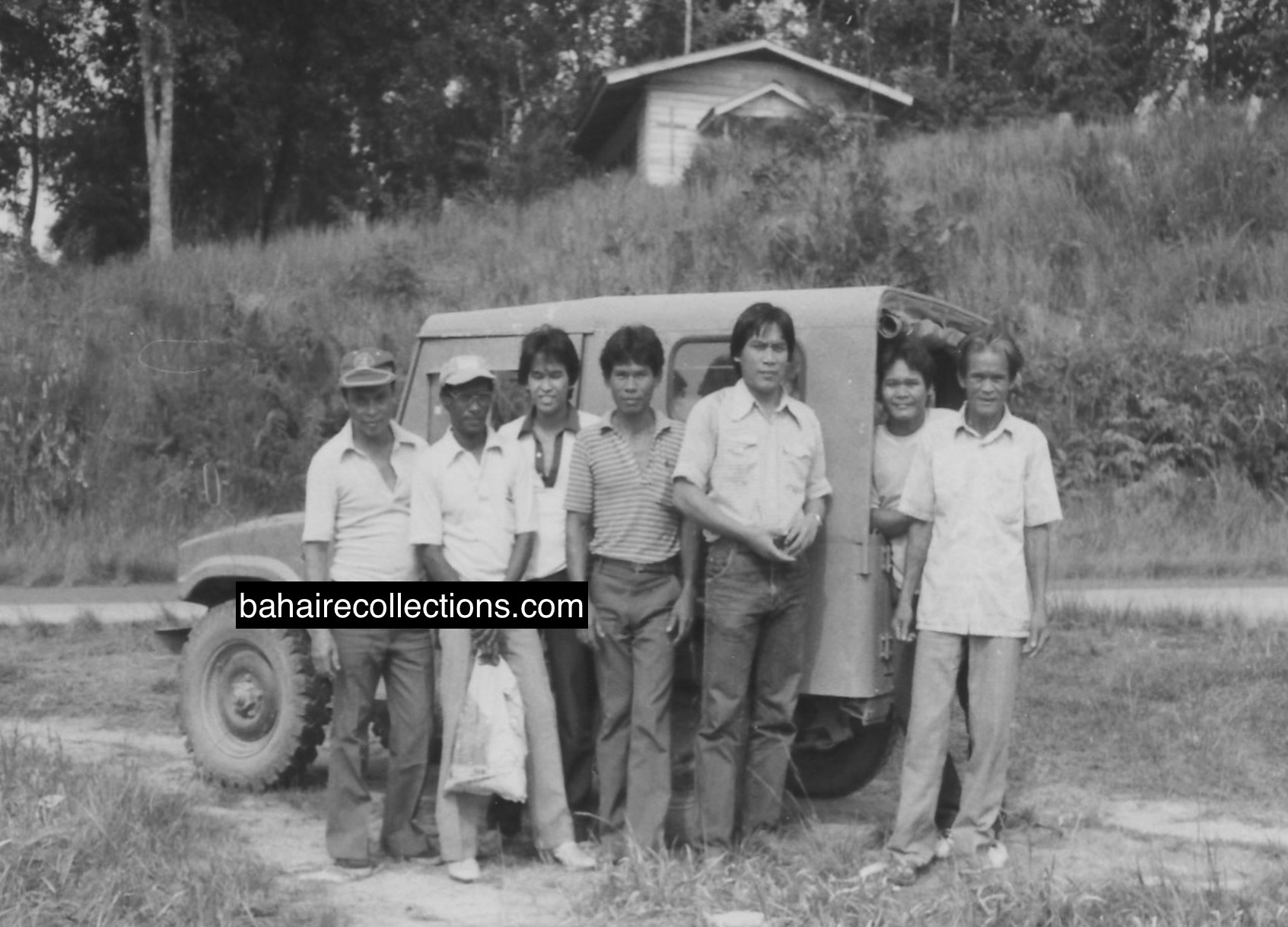
Teaching trip to Semukoi, Serian, 1983. L-R: Ragai Lang, Maniam, Jemeni Indin, Gunjus Mancha, Dajai Mancha, Lenyau Gelai and Umap
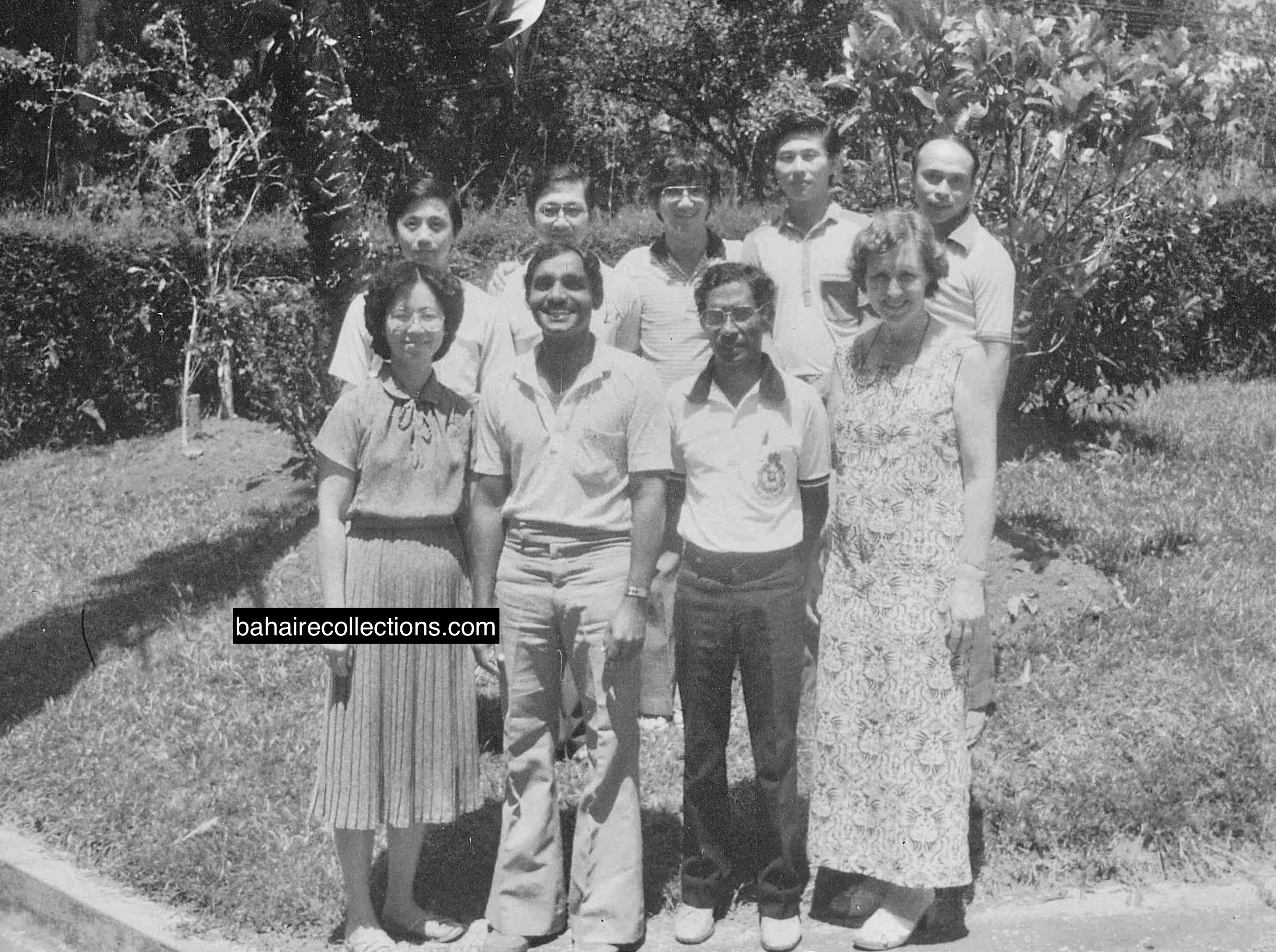
National Teaching Committee of East Malaysia for 1983. L-R: Miss Lai Kia Chin, Ramu Naidu, Maniam and Grete Fodar. Back Row L-R: Tay Yang Huang, Lim Pun Huat, Frankie Ang, Michael Soo and Ragai Lang
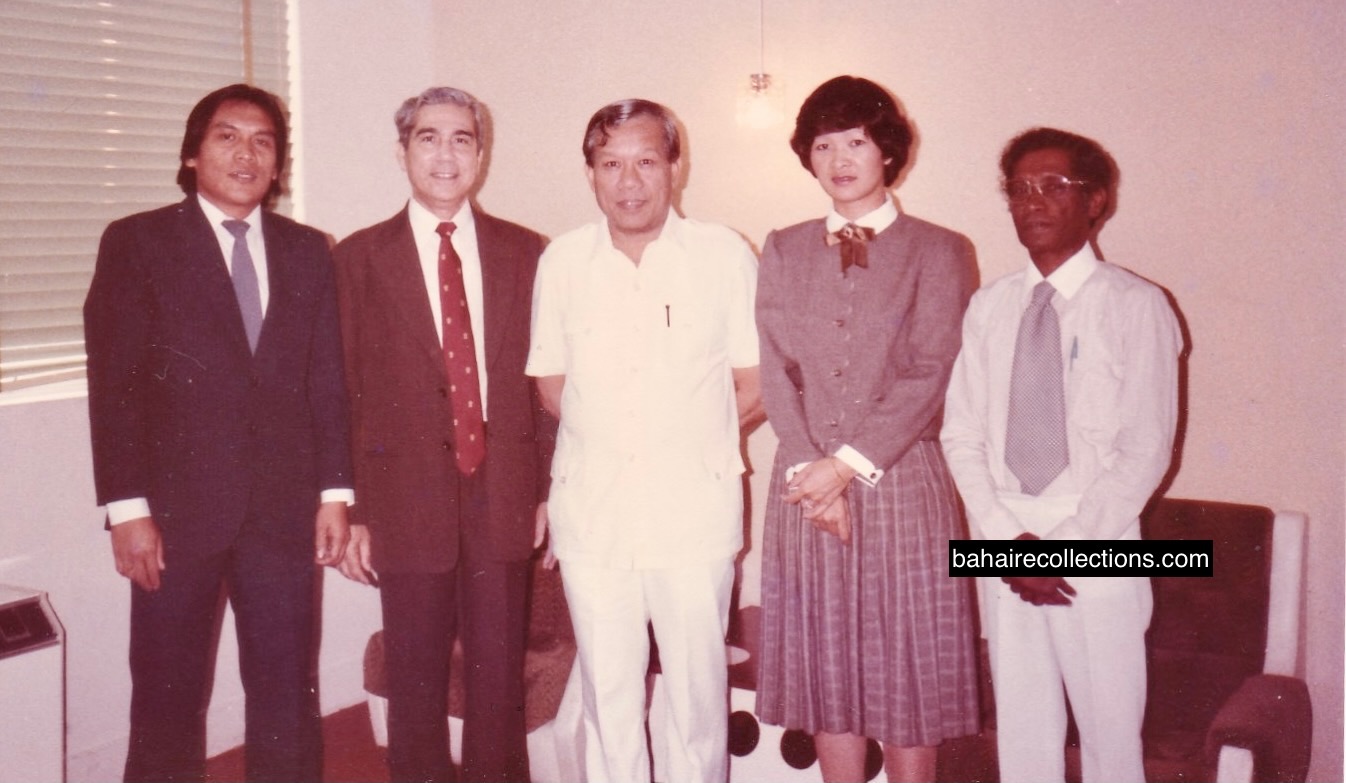
Courtesy call upon Federal Minister of Education, 1984. L-R: Dajai Mancha, Counselor Dr. John Fozdar, the Education Minister, Datuk Sulaiman Daud, Winnie Hee, and Maniam
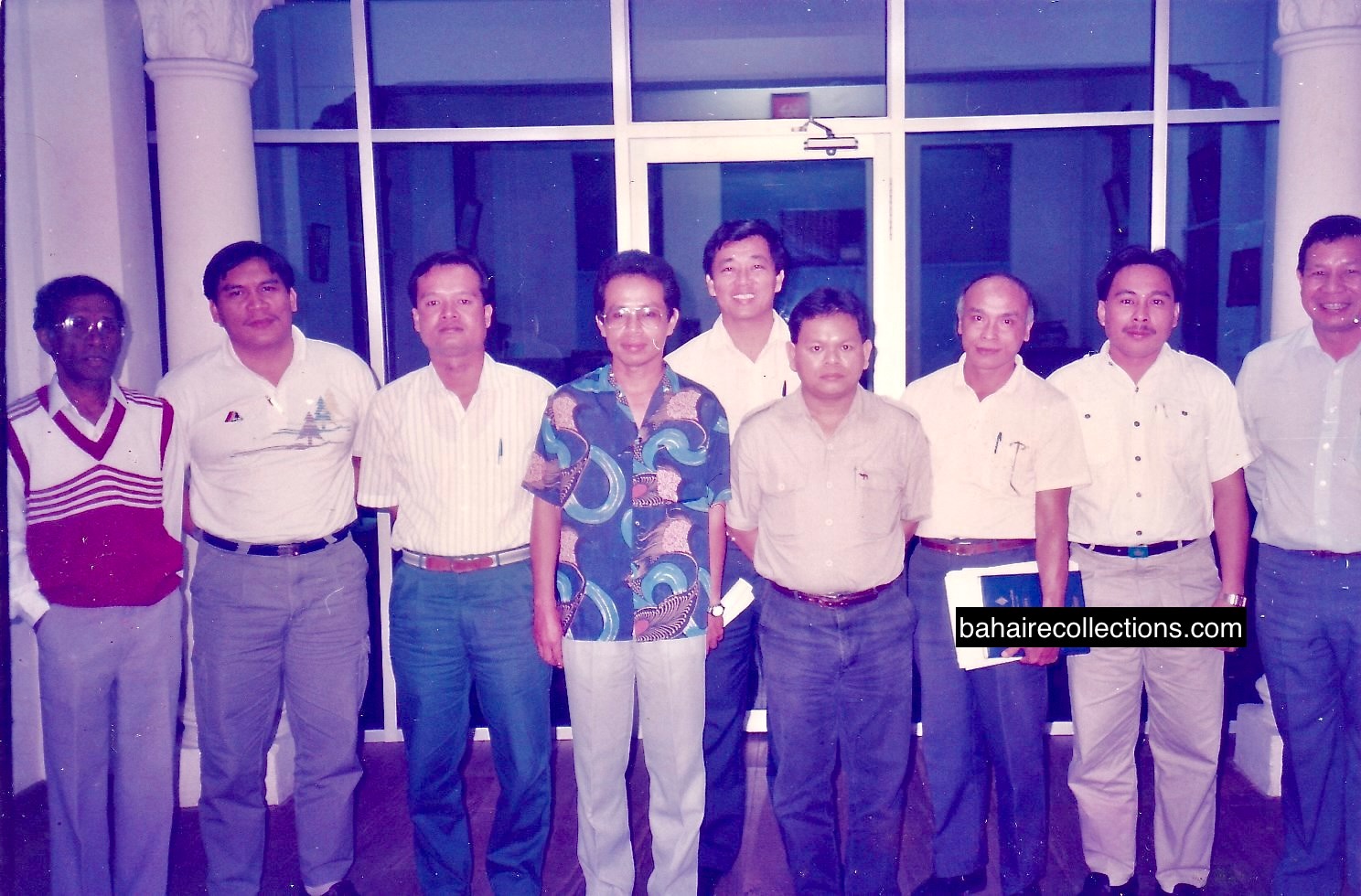
First State Bahá’í Coouncil of Sarawak, 1991. L-R: M. Maniam, Dajai Mancha, Suai Kirak, Narong Singau, Robert Ting, Salam Chimi, Ragai Lang, Tipik Ladi and Mcmillan Bau
Maniam had moved closely with many elders in the Faith and with many members of institutions. Maniam kept in touch with his old friends in Malacca and in each trip back to West Malaysia, he did not fail to call upon his close friends, among others, Kumara Das, Anthony Louis, and Jami Subramaniam.
Maniam and his wife did not have children of their own. As true lovers of humanity, Maniam and Nyamut consulted and adopted two girls and one boy from the relatives of Nyamut. Srimathy Maniam and Srinur Maniam are the girls, and Sri Purna Maniam the boy.
Towards the end of his life, Maniam became very ill, owing to various complications caused by diabetes and heart ailments. Having some premonition that his end of the earthly journey was near, Maniam started telephoning his relatives in West Malaysia and requested them to visit him before he was no more. Dr. Sri Ganesh who had served with Maniam on the National Spiritual Assembly for several years heard about his deteriorating health situation and flew down to Kuching in June 2008. He went through the medical reports, including the X-rays. He sadly informed Sri Mathi, daughter of Maniam that everything was now in the hands of God. Among the local friends who visited Maniam were Dr. John Fozdar and Mrs. Grete Fozdar. Within days Maniam succumbed to severe pneumonia. His health situation worsened when his lungs shrunk and caused breathing difficulties. On 10 July 2008, he was admitted into hospital and passed away at 1:59 pm the same day.
The passing of Maniam came as a big blow to his family, close friends, and relatives. One of the closest friends of Maniam who could not take the shocking news was admitted to the hospital. Many others could not come out of the trauma caused by this unexpected shock. Several friends came to pay last respect to a lovable friend, who had dedicated a full fifty years for relentlessly promoting the Cause of Bahá’u’lláh. Mr. Ragai Lang, his close friend, and co-worker placed accolades on Maniam at the funeral ceremony, organized by the Local Spiritual Assembly of the Bahá’ís of Kampong Triboh. Following a befitting burial ceremony, the earthly remains of Maniam were buried on the following day of 11 July at Kampung Triboh, Sarawak. He leaves behind his widowed wife and three children, and more than that fond memory and indelible track of his long and glorious services to the Cause in a land in which he had chosen to bury his bones.
Maniam shall always be remembered for his deep and unshakable commitment to teaching the natives of East Malaysia. He was one of the Bahá’ís of the Ten-Year Crusade period to have left the shores of West Malaysia for the then difficult Sarawak state. Maniam witnessed for himself the growth and steady development of the Faith shaping up right in front of his eyes during the more than four decades he lived there, with himself playing a significant role in that historical enterprise. Although Maniam was not a very highly successful businessman, he shone in-field teaching as a brilliant pioneer. He mastered the local Iban language and moved very closely with them, often spending many nights in the longhouses. It is said that there is no one longhouse that he had not visited in the interiors of Sarawak. He was often called the “backbone of Iban longhouse teaching”. He came to be loved very much for the very sincere love he himself showed them.
Maniam led a very simple and humble way of Bahá’í life, always radiating immense love through his broad and cheerful smile. His love for the Blessed Beauty and the Faith was beyond measure. Maniam practiced a good host to the early batch of travel teachers and pioneers from West Malaysia and abroad who visited Sarawak. A strong-minded person, Maniam’s constant advice to the younger Bahá’ís to live the Bahá’í way of life to be effective in the Cause and to attract others into the Faith. Maniam was always a very firm disciplinarian expecting a high standard of moral conduct and rectitude from the youth. He was very direct in advising them on Bahá’í matters. He always wanted tasks assigned to be carried out to the best. He drove home the cardinal point to the believers not to seek name, fame, or recognition and that one should serve the Cause only to earn the good pleasure of Bahá’u’lláh. What was important was for the names to be remembered by Bahá’u’lláh, not by the mortal beings. Deep inside Maniam was a very loving and caring person to those who knew him well. Throughout his life, Maniam had attempted to involve in business, where he had ups and downs, which forced him to live a simple life. Yet in service to the Cause, he was highly successful. Maniam, along with a few early workers of the Cause shall always remain household names in the history of the Faith in Sarawak.
Maniam’s long record of outstanding, unremitting, and highly meritorious services in Sarawak shall always remain unforgettable in the annals of the Faith. Rising generations of Bahá’ís will take immense pride in remembering him and emulating the spiritual path he had led and left.
A. Manisegaran
31 October 2021
Copyright@bahairecollections.com
27 thoughts on “REMEMBERING M. MANIAM”
Thank you Mani for penning this wonderful and inspiring account of M. Maniam’s dedicated service to the glorious Cause of Baha’u’llah. Maniam was my first teacher of the Faith. Touching memories of my early days as a Baha’i flooded me. Interestingly, I happened to see myself in the photo published in the blog. That was taken in Bagan Serai town in 1966. I am standing 2nd from the right and Rajagopal with black tie is next to me. He was the teacher who had invited us to his house for a fireside where I heard of the Faith for the first time from Mr. Maniam who was the speaker. The 1966 photo was taken in the school where Betty and Rajagopal were teaching. All the youths were students at the Government English School, Bagan Serai. The visiting American Baha’i was from Hong Kong and worked with Motorola.
Thanks again brother Mani for evoking fond and sweet memories in my mind of events that happened more than half a century ago. Loving regards.
Hua Keng Tong
Skudai
Malaysia
Mr. Manisegaran our living historian has recorded for posterity a very beautiful memory about Mr. Maniam. I must thank him profusely for highlighting one of our very own Dawn Breakers who was an early instrument in opening Sarawak to the teachings of Baha’u’llah.
This story brought the fondest memories of my association with M. Maniam, fondly known as Penghulu Maniam. He never had any excuse not to visit the longhouses in the interior of Sarawak whenever there was a need. He has developed himself painstakingly to be part of the Iban community in Sarawak by learning and speaking fluent Iban language and very quickly learned their customs and their way of life. Teaching the Faith to the natives of Sarawak was in his blood till the end of his earthly life. I had known, stayed and travelled with him to the villages in Serian in Sarawak a couple of times in late 1980s and 1990s.
Pandian Thangapandy
Ipoh,
Malaysia
Dear Manisegaran
Your detailed account on the late Maniam, and my very close friend was very good. As l read through, tears were following and my heart was bleeding, as l came across the names of other co-workers who had passed away.
Maniam was my spiritual father through whom I accepted the Faith. We later worked together in both administrative roles and field teaching.
Thanks so much for your good service.
Ragai anak Lang
Sarawak
That was really a very moving story about great pioneer. I notice there was a great deal of activities during his early involvement in the Faith in West Malaysia. From what I have read Maniam seems to have done more in Sarawak. He had visited several rural communities. Of course beside being on the National Spiritual Assembly of Malaysia, he has served on the National Teaching Committee, Bahai Teaching and Administrative Committee and the Bahai Council, to name a few.
While travelling Mukah in the late 1970’s people called him the prophet of the Bahai Faith. In fact, Dr John always told the story that when some Bahais went to his clinic, they would even refer to Maniam as prophet of the Bahai Faith. That was probably because of his aggressive teaching activities. But Dr. John had to correct them.
We are all very thankful for what you are doing to record the services of such blessed souls.
Tipik Ladi
Sarawak
I just read the article about Mr. M. Maniam. I first came to know about the Bahai Faith in 1972 through Mr. Maniam. He came over to our school, SMK SEDAYA, Kanowit. He gave a talk one afternoon after lunch. My friend , Bundan Liban and I were among those who attended the talk. We declared there and then. Nevertheless, we were not deepened in the early days. Only when I continued my study in Dragon School, Kuching (Form 6) I came into contact with Mr. Maniam, Dr. John Fozdar, Mrs. Grete Fodar and the other believers, It was in Kuching that I was more involved in the Faith and serve in committees. It was in Kuching that my faith grew and sustain me until now.
Suai Kirak
Sarawak
Thank you Mr Manisegaran for your invaluable and memorable story on the late Penghulu Maniam. I was very touched by the ways and years of selfless service that Maniam gave for Baha’u’llah for almost half a century. It is both inspiring and feel motivated that one can do more too in the field of service to Baha’u’llah. I am greatly inspired and motivated by Maniam’s life to do more for the Cause in the coming 9 Year Plan.
Thank you again !
Lim Pun Huat
Sarawak
Dear brother Manisegaran,
That was a very good and inspiring story on my spiritual father M. Maniam. Suai ak Kirak and I declared during the time when Maniam visited our school in Kanowit. He sought permission from Mr. James Foh, the school Principal, to give a talk about the Faith. Mr. James announced during the school assembly that anyone who wanted to know about the Bahai Faith could gather at girl’s dinning hall. Many of us attended, while Suai ak Kirak and I sat at the front row. After his talk Maniam gave a pamphlet. He gave a declaration card and we declared just like that. I remember well there was not enough declaration cards. Suai and I were lucky, all because we were at the front row. This was in 1972 while I am in form 3. Your story has connected my memory to the day I was born a new person some 50 years ago.
Bundan Liban
Sarawak
Dear Mani,
I read your wonderful write- up on our beloved “ Penghulu “Maniam. Such a very touching and moving story of an ordinary human being, inspired and galvanized by the spirit of the Faith who served the Cause of God with such zeal and sacrifice. Your work on Maniam, will undoubtedly inspire generations beyond the reach of time. God bless you Mani, for such profound work you are doing for the Cause of God.
Professor Dr. Anathan Krishnan
Puchong
Malaysia
Dear Manisegaran,
Thank you for writing this very inspiring story about M.Maniam. He had really devoted his entire life for service to the Cause of God.
I had a very good experience working together with him in the field of teaching to rural communities. I also served on the Local Spiritual Assembly and the State Bahai Council. I had learned many things from him in the fields of teaching and administration. He shall always remain an unforgettble believer in my life.
Dajai Anak Mancha
Sarawak
Malaysia
Dear Mr. Manisegaran,
This story brings me to tears, when reading about this beloved Bahai Uncle, Penghulu Maniam.
In our last journey out of Sarawak where we spent some years, especially in Kuching due to my dad’s call of duty in the Armed forces , it was Uncle Maniam who sent us to the airport, in his somewhat mini Moke car. I was only six years old then.
Together with the late Captain Choo Yeok Boon, Uncle Maniam has been our family’s constant source of inspiration and guidance till we departed the land of Sarawak.
I have met Uncle Maniam several times in Kuala Lumpur when he was here for NSA Meeting.
Through your article, today I have learnt the many sufferings that he has been through in teaching our beloved Cause in the interior areas of Sarawak.
Interestingly I read in your article about the date of declaration of Uncle Thinathayallam Ponnusamy who still serves the Faith with distinction and on whose hands my two boys grew with.
I am truly privileged to have known and met all this stalwarts of the Faith through your blog. They are irreplaceable and have paved an easier path for us, as they took the suffering and hardships upon themselves.
My ardent prayers for the progress of their blessed souls in the Abha Kingdom.
Vijay Saravanan
Subang Jaya
Malaysia
I read the story of Maniam with great interest, and with tears. May be I feel so much for Maniam as he was a fellow pioneer and I know what a pioneer’s life is like.
I first heard of Maniam from my fellow pioneer Bijan Bayzaee who came to Laos where I was pioneering since 1962. Bayzaee was travel teaching with Maniam in Sarawak for close to nine months before he came to Laos for pioneering. Bayzaee mentioned much about Maniam and Yankee Leong with whom Bayzaee started off the teaching work in Sarawak. Bayzaee had so many nice things to say about Maniam. Since then, I had always, wanted to meet Maniam.
It was only in later part of the sixties, I believe in 1967 that I met Maniam when he was visiting Malacca and was about to return to Sarawak for good. Even in later years I had met him a few times in Malaysia at conferences. When I first met Maniam, he spoke of great things about Bayzaee. It was sincere, and truthful saying good things about the services that pioneers sacrificially perform. The qualities which I found in both Bayzaee and Maniam. In my private conversations I found Maniam as a man of humour and he had many jokes to share.
But reading the story is something else, it gives me a fuller and richer picture of a great giant in the field. I regard Maniam a veteran and a real hero of the Faith. He has sacrificed much and has surrendered his entire life for the Cause of Bahaullah. He had gone into such difficulties when going into the interiors.
To me this is one of the highest valued stories published in the blog. It carries information, inspiration and so much spirit, supported with very heart capturing photographs which speak volumes. This is preservation of history for posterity. The fruits of this blog will be valued and appreciated by the future generations.
Dr. Firaydun Mithaq
Chieng Mai
Thailand
My first encounter with late Penghulu Maniam was in Bagan Serai, Perak at the residence of Betty and Tony Fernandez. This was probably in mid 1966. Maniam was a home front pioneer in Bagan Serai.
I first heard of the Bahai Faith in 1963, when Betty had come as a substitute teacher to my class in the Bagan Serai Government school where I studied and introduced the Faith. I joined the Royal Malaysia Air Force in June 1964 and by September l was sent to Australia for my mechanic course. In Sidney there was an advertisement, a huge poster along the railway lines that tempted me to accept the Faith. The eight months course was over l was on one week vacation. I went back to Bagan Serai in early 1966, and Thinathayallam, my senior in the school and one who had already become a Bahai came to meet me on the possibility of he joining the Air Force. He then took me to see Penghulu Maniam who was instrumental in my signing up with the final push coming from him. I signed up as a believer in the dining hall of the house of Betty, and she presented me a prayer book and the famous book Bahaullah and the New Era.
Maniam impressed me very much of our Faith and this impression never changed. Years later when l was in Labuan island off the coast of Sabah, he visited me and advised us to set up a sort of a Bahai committee, pending the establishment of a Local Spiritual Assembly. I met him many times after my first encounter, and we always had very nice chats, but it was always about our beloved Faith.
Maniam was always a wonderful and consummate Bahai and my mentor. In my humble view he was a true pioneer whose only object was to teach and serve the Faith. He was a truly devoted soul. l was absolutely devoted to him for his many qualities and besides being a great no nonsense person, he was also very humble.
Thank you Manisegaran, your story justifies this great person and you have done pure justice to a beautiful soul. If I may add, you are a prolific writer, all your biographies up to now are so well written with seamless flow. Maniam’s article is flawless and you can’t stop halfway. We are bless to have a writer such as you.
Much Bahai love and regards
Munusamy
Rawang
Malaysia
Reading about the life and legacy of Penghulu Maniam makes me proud that he has made the history of the Faith proud and decorated the pages of Bahai history.
I had known Maniam from the Malacca days. We accepted the Faith around the same time. He was a very simple boy then. I knew some of his relatives too. I remember the Sunday Classes that he attended. Even in the early days he showed sign of keen interest in serving the Cause. He followed Leong Tat Chee, Bhaskaran, and Kumara Das and me for estate teaching. When he decided to go to Sarawak we gave him all the encouragement. He underwent a lot of sufferings in Sarawak, and yet he persevered and soldiered on with the love of Bahaullah in his heart. Whenever he came back for visits, he was sure to meet up with some of his old friends, who all loved him for the example he had set.
While I am clear of his days in West Malaysia, this is the first time I got the full picture of the works that Maniam had carried out for the Cause in Sarawak. They are mostly new and news as well to me. Thank you Manisegaran for digging deep inside to bring out those details, which would be well preserved for posterity.
While feeling proud of a great friend and his services, his passing reminds me one more time that most of my peers have gone to the Abha Kingdom, with only a handful of us remaining. I spend my time praying for all those valiant souls like Maniam who must have surely earned the good pleasure of our Creator.
Anthony Louis
Malacca
Malaysia
Thanks Mani for the detailed account of Penghulu Maniam’s Baha’i life from the time he declared in 1957 till he took flight in 2008 to be amongst the valiant souls in the Concourse on High, a span of more than half a century.
Right from day one his life was jammed packed with teaching activities for the Faith. I am particularly struck by his humility, strength, and loyalty to the Faith, that despite poverty and having to depend on the friends to the extent of surviving on bread crust; he persevered and soldier on. I am impressed that he knew the ropes of negotiation in averting a strike in the rubber estate involving Baha’is who worked there. A Baha’i teacher needs more than teaching skills and knowledge. His early teaching activities in the Asli areas and the estates were already amazing and certainly served as a prelude to a greater and more astounding teaching role in the Iban longhouses in Sarawak. Forming 100 Assemblies through vigorous teaching is not only incredible but to me, a miracle.
While I was aware of his exploits as a travel teacher through Baha’i News and newsletters, I only knew him personally when I joined him as a fellow colleague on the National Spiritual Assembly in 1979. Certainly, his knowledge and experience in teaching the Ibans and the Aslis in the interior proved useful in the decisions and plans of the National Assembly. He believed in less talk but more action. Indeed, besides being an excellent Baha’i teacher, I am very impressed with his multi-talented skills in the area of repairing radios, typewriters, cars, selling insurance and air tickets. Yes, I had been to his gift shop, which sells everything besides gifts, which the army base needed. He is certainly an enterprising person.
He was a survivor, a miracle worker. In fact, I feel that if he wanted to, he could have become a successful businessman, but his priority was different. If not for his skin colour he was every inch an Iban. He lived, spoke, ate, dressed, and danced like one, practised their culture and married one too, certainly the embodiment of a true pioneer. He was a “Penghulu” for the friends who reached out to him for counsel and guidance.
Lum Weng Chew
Toronto
Canada
I must have known or seen Mr. Maniam since I was a little girl because my papa knew him then. Unfortunately, I cannot remember much during that time. From your write up, he seemed to have visited and stayed in Kapit area for quite sometimes. As he was the only Indian in town, I think nearly all the town people knew him.
I left Kapit in 1970 but I did meet him in Kuching occasionally when I was doing my nursing training there. What I can remember, and share is that he was a very friendly and loving man. Always created jokes. He was very hard working in spreading Baha’u’llah’s teachings. I always liked listening to him talking about the Faith. I am sure he faced a lot of challenges while in the field, but I have never seen him looking sad.
Thank you,
Rose
Sarawak
That was a very good recollection of the legacy of Maniam. I was fortunate to have served with Maniam in Sarawak, especially Kapit in early 1963. All those narrations reconstruct in front of my eyes events that took place some 60 years ago. Good this is recorded for posterity.
Maniam and I were both born on the 5th of December. He was five years my senior. We worked at pioneering posts as a team and each one did what he was best at. Together, with the guidance and encouragement of the beloved institutions, we made a strong front for promoting the Faith and deepening the newly-enrolled believers. If general circumstances could allow, including our visa renewals, we could carry on out team work for much longer.
Maniam and his beloved family members are always in my thoughts and prayers. He, the outstanding servant of the Cause, was created of an essence that one could recognize it in the life of the saints of the ages.
Bijan Bayzaee
Chicago
USA
Thanks brother Manisegaran for your deep research work on a genuine believer Maniam over his 50 years of spiritual crusade. As soon as I completed reading the story I rang up my close friend in Malaysia, Mr. Muniappan to find out more about him. Muniappan had met him once or twice at Bahai gatherings in Kuala Lumpur. Maniam was most of the time in East Malaysia and seldom he was in West Malaysia, as I understood from Muniappan. In my few visits to Malaysia too I did not have a chance to meet Maniam for the same reason.
The story was so thrilling that I read it twice and shared widely among my contacts. The life and experiences of Maniam is likened, in many ways , the heroes of the Faith during the heroic age of the Cause. In the same vein, Maniam, forfeited the joys of a comfortable life when he was just 20. He opted to be a servant of God to promote His Cause for the rest of his earthly days, which he has done so well. I was particularly moved to learn that he and Bayzayee had started off their services in the Kapit area which was the toughest in those days- an area infested with mosquitoes, unknown land, and with people of unknown culture and language , and sleeping in boats and living on breadcrumbs. It did not take long before he won the love of the people among whom he served. In my view Maniam was certainly one of the founding fathers of the Faith in Sarawak.
Maniam must have been a person of tact and wisdom. While in West Malaysia, he dealt with a dilemma with much tact and diplomacy. And that was getting the believers to keep away from strikes, for which the management rewarded him.
I am moved to say that Maniam had boundless love for the Cause, and above all the commitment and sacrificing nature in him that had made him a very successful pioneer. I am proud to have known this God- intoxicated Servant through this blog. Certainly, and eagerly looking forward to the next story.
With loving Baha’i greetings.
Veenaud Boodhun
Mauritius
Dear Mani
What a great account of one who had made Bahaullah the center of his life. I first heard many great things of Penghulu Maniam from my friend Mari, who is a veteran teacher of the Faith in the aboriginal jungles of Malaysia. I had formed a mental and imaginary picture of Maniam. I had not seen his photo as well anywhere. Since hearing of Maniam from Mari I had wanted to meet him in person. Sadly, he has passed away. That saddened me.
But you made my day by publishing this moving story on Maniam. I went through all those wonderful photographs first, and then read through the story. He is clearly bigger than what Mari had related to me. I would call Maniam one of the greatest gems among pioneers, one of the rare pearls in the ocean of believers. He has dedicated his love, energy, strength, and everything in life for the Cause of God. He may have lived a simple life, with reasonable means. But I am more than confident that our Heavenly Father is sure to bless him abundantly for the great services he has rendered, the sacrifices he has made, and for laying his life in the land where he had chosen to bury his bones as a pioneer. Truly a remarkable man never to be erased from the luminous pages of Bahai history.
Ronnie Koh
Kajang
Malaysia
Thank you Uncle Manisegaran for the very beautifully written story on the late Mr. Penghulu Maniam. I remembered uncle Maniam well as he was close to our family and was much loved. He was firm, simple, and steadfast with dedication devotion was a soldier of Bahaullah for decades. So wonderful for souls who have chosen the path of God to serve and sacrifice. It’s a path that few brave ones would choose. His was a life to fulfill the purpose of a Godly life and a reminder for all of us to walk the holy path.
Shyama Evelyn Thevar
British Columbia
CANADA
Dear Mani,
My personal touch with dear Maniam began during my interactions with Raymond Peter in the yearly months of 1963 when I was curiously interested to know what the Bahais were up to.
While I was strongly prejudiced to any belief system other than the Catholic Church, I was kind of surprised to see an Indian of Hindu background demonstrating a vision of understanding, clarity of purpose, and sincerity of dedication that I never suspected could exist in any religious enthusiast other than a Catholic evangelist. I could clearly see that he has become deeply touched and wholly captivated by a transforming spirit that has conditioned him to live ONLY to spread the message of Bahaullah.
He became another reason for me to investigate who really Bahaullah is. Now, when I look back in retrospect at the Maniam that interacted with me, I can clearly see that indeed he was the embodiment of that “unrestrained wind” that Bahaullah wished every Bahai teacher to be. I saw in his presentations that “seize thy chance” eagerness and vigor to “diffuse the divine fragrances’ to WHOEVER he meets. Whatever he did throughout his life was a continuum of living and dying for our beloved Faith. He was also one of the exemplary pioneers who inspired me to keep on trying to be that ” unrestrained wind”.
God bless his soul. God bless his chirpings that will keep on echoing throughout history.
Joseph Swaminathan
Mentakab
Pahang State
Malaysia
Dear Mr.Mani,
Thank you for penniing the story of another valiant servant whose services are highly commendable, especially in his teaching the Faith to the indigenous people – the Ibans of Sarawak.
Mr. Maniam in his life time can be called one of the Torch Bearers of the 10 Year Crusade. He really and completely immersed himself in teaching activities and adapting the indigenous culture of the region he served. He had learned the Iban language and finally got married to a lady of that race. Glad to learn that he was accepted as one of them and came to be known as Penghulu. Hats off to Maniam for his untiring services, strives and endeavors towards teaching the Faith to the indeginious people in Sarawak. Thanks to our early stalwarts, Knights and many Hands of the Cause of God for their highly esteemed guidance and services rendered to reach such people in this country. And Mr.Maniam, too fall in to that category an awe – inspiring soul.
In Malaysia, from the time of inception of the Faith here, teaching activities were focussed on all strata of society. Today we already have vibrant communities in Malaysia deriving from the indigenous friends.
Praying that a high station always reserved for Mr. Maniam in the realm of God
Thank you
Pitamboro Komoro Naiko
Kuala Selangor
Malaysia
Dear Mani
I read with great interest and pleasure the story of Penghulu Maniam which you had ably penned.
My own association with Maniam was primarily when I was a junior primary school kid. Despite all the tribulations faced by him as vividly elaborated by you Maniam was indeed a very kind, empathic, patient and generous soul. He displayed these characteristics many a time when he stayed with us in our government quarters during his travels to Malacca. I remember Maniam scouring with me in rickshaws looking for frequently elusive drawing paint and accessories from early morning till dusk. Also trawling together in the mud through murky padi fields and streams for fighting fish, tadpoles and shrimps. This is about what I could say about my personal association with him.
But that he has done so much for the Faith, especially in Sarawak should and would always be part of the history of the Faith in Malaysia. He was surely a quiet worker, centering all his energy for the furtherance of the Cause. He was not only teaching the Faith but also sincerely lived the life as espoused in the teachings of Bahá’u’lláh. A rare breed indeed. He was larger than life.
Thank you.
Daven Dharmalingam
Sydney
Australia
Dear Uncle Manisegaran
Thank you for the beautiful recollections of my late father. I am blessed to be brought up by him. He once told me, even if I am not with you physically, I shall always be with you spiritually. On behalf of my family I wish to thank the writer of the story, all readers who commented with such lovely words, and all those who remember him and offers prayers for him.
Srimathi Maniam
Sarawak
Thank you Mani for this wonderful write up of yet another worker for the Cause who was a workaholic for the Cause.
Maniam answered the call to pioneer and thus began his tireless teaching work into the interior of the Sarawak. He brought to the indigenous people of Sarawak the Glad Tidings of Bahaullah. That is the greatest undertaking with which he had left his mark in the history of the Faith in Sarawak. To be honest to what he believed in the unity of mankind, Maniam married one of its own natives and became one of their own. His soft tone and humility will always stay in my memory. One word that I choose to summarize on Maniam is Sacrifice. Penghulu Maniam sacrificed his time and physical self to His Divine Cause and stood steadfast in His Covenant till his last breadth.
The world needs such believers in abundance to make this place a better place. He shall always be a shining example to many in the current generation and generations yet to be born.
Jayadhan
Kuantan
Pahang
Malaysia
Dear Mr. Mani,
The “Penghulu” Maniam’s story is yet another remarkable recollection that touched my heart to the core. The valued-added services he had rendered in the promotion of our beloved Faith in Peninsula Malaysia and the state of Sarawak is particularly exemplary. He demonstrated as a diligent fieldworker and a committed servant of Bahá’u’lláh till the end of his earthly life. I marvel at his extraordinary level of steadfastness for the love of Bahá’u’lláh.
I am constantly reminded by the words of the beloved Master, … “You are the angels, if your feet be firm, be steadfast as a rock that no earthly storm can move, and as you have faith so shall your powers be, and know that till the end I am always with you…”
Further, I clearly see a powerful spiritual connection between the early stalwarts when comes to sacrificial services in the field of teaching – whom I religiously believe were hand-picked by the Blessed Beauty.
May he continue his wonderful service in all the realms of God.
Love,
Velayutham Gopal
Phnom Penh
Cambodia
I am very happy that this story about M. Maniam’s life has been written and will be available for posterity.
I first met Maniam when he returned to Sarawak in 1967. Our home, at Mile 2 1/2 Rock Road, at the time doubled as the Baha’i Centre of Kuching. This was one side of a block of two connected two story shophouses (the other side being New Era Nursing and Maternity Home started by my husband Dr. John, to be able to do minor surgery). Maniam and other travel teachers would stay with us when in Kuching for short periods. We all loved Maniam, particularly the children!
After reading about Maniam’s early life I just wish that I had known about it before we arrived and before he came back or even later. I could have learned so much more from him. Maniam was trained from the time he became a Baha’i to be a teacher of his new Faith. Unfortunately, Maniam had to leave just over a year before we arrived and after more than a thousand native Ibans accepted the Faith in Kapit area alone.
Several pioneers and travel teachers served in Sarawak during the more than 10 years from the time that Jamshed Fozdar and family left, and we arrived in Sarawak. All had left by then except Harlan Lang, a pioneer from USA who arrived several months before us. He stopped in Sandakan on his way to get some idea from Dr. John of what to expect in Kuching and what to do. Kuching had a Local Spiritual Assembly and probably Kanowit and Kapit. A local travel teacher, Lalok, a native of Kenya was employed as a travel teacher to stay in touch with the native Baha’i communities in Ulu Kapit, the only ones in Sarawak at the time.
I believe that Minoo Fozdar was in touch with him and others and he himself travelled at least once to Kapit and Sungai Gaat. According to Minoo Fozdar financial assistance was provided by Jamshed Fozdar through Minoo Fozdar.
Generally, the Faith in Sarawak was without effective leadership. This was the main reason for my husband and our family to relocate to Sarawak.
Grete Fozdar
Kuching
Sarawak
Malaysia
I am one of the children who loved Maniam in my mothers comment above. We had great respect for him and always referred to him as ‘Mister M Fullstop Maniam”
The strongest memories I have of Maniam from my childhood was when we went to Sungai Turong for the opening of the first rural Bahaí Centre in Sarawak in 1969. The whole longhouse and all of us children were waiting excitedly the whole day because we had heard Maniam was going to perform a play in the evening and Maniam’s plays were always great fun. Sure enough in the evening Maniam appeared in front of the whole longhouse dressed as an astronaut who got lost and turned up by accident in the Sarawak jungle – the whole community collapsed in laughter. When the play was over the celebrations continued late into the night and we all had to dance Ngajat several times before we children went to sleep and the adults probably continued until the morning.
Bahá’u’lláh has been very kind to us for giving us such wonderful friends and memories.
Kamal Fozdar
Perth
Australia